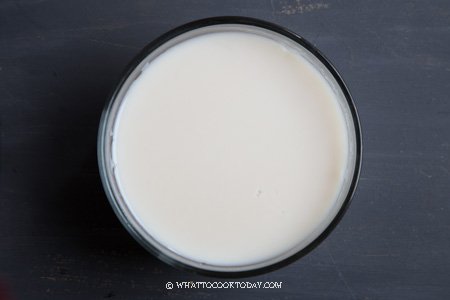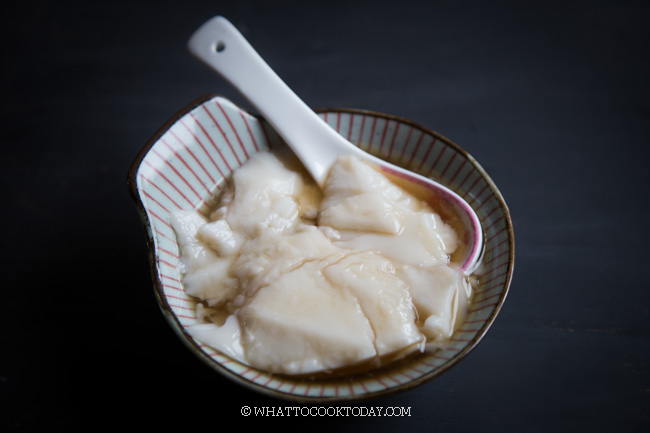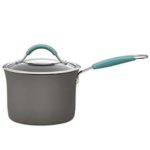This post may contain affiliate links. Please read our disclosure policy.
Make this soft, wobbly, and smooth Chinese-style tau foo fah from soybean milk (or any milk) without using gypsum powder or GDL. The dou hua is served with easy delicious ginger syrup.

What is dou hua / tau foo fah ?
Chinese dou hua (豆腐花) is a traditional Chinese dessert made from soybeans. It is often referred to as “tofu pudding” or “soybean pudding.” It is also known as Tau foo fah in Cantonese or dou hua in Mandarin or tau huay in Hokkien or Kembang Tahu Jahe in Indonesian language, is one of my favorite childhood desserts/snacks. Dou hua is a soft and silky dessert with a texture similar to custard or panna cotta. It is known for its delicate, melt-in-the-mouth consistency. There are many regional variations of dou hua in China, and it can be served in various sweet or savory forms. It’s a popular street food and dessert in China and is enjoyed by people of all ages.
WHY YOU WILL LIKE THIS TAU FOO FAH RECIPE
1. NO CHEMICALS
Traditional tau foo fah is made by boiling the soybean milk and then GDL or gypsum powder is added to help the soybean coagulate into a pudding-like texture. This recipe doesn’t use that and only utilizes the good ol’ agar agar powder or gelatin powder
2. EASY AND CONVENIENT RECIPE
You don’t have to make the soybean milk from scratch. You can if you want to. I use organic unsweetened soybean milk and it turned out just as good and so much less work for real
3. YOU CAN USE DIFFERENT TYPE OF MILK
You can use other types of nut milk or dairy with this recipe. I have tried almond milk, cashew milk, and regular cow’s milk and they work just great.
INGREDIENTS
You only need 2 ingredients to make this dou hua : Plain unsweetened soybean milk, agar agar powder or gelatin powder.
For the ginger syrup: fresh ginger, brown/white sugar, water.
Dou Hua /Tau Foo Fah (Soybean Pudding-using agar agar or gelatin)
Ingredients
- 1000 ml unsweetened plain soymilk
- 1 tsp vanilla extract optional
If using agar agar:
- 4 g agar agar powder 1 1/3 tsp, see notes 1
If using gelatin powder:
- 13 g gelatin powder 1 Tbsp + 1/3 teaspoons
Ginger syrup:
- 250 g water
- 200 g brown sugar or palm sugar more or less to your preference
- 25 g fresh ginger peeled and thinly sliced
Instructions
- PLEASE NOTE: I recommend using standardized measuring spoons or a digital weighing scale to measure the agar agar or gelatin. If you use measuring spoons, make sure you scoop and level it. I prefer to weigh with scale for accuracy. Agar agar is a powerful thickener/stabilizer and using too much or too little can affect the result
Prepare the ginger syrup:
- Place everything in a saucepan and bring to a boil and then lower the heat to low, cover and let it simmer for 15 minutes. Turn off the heat. Strain the mixture and let it cool down. Store in the refrigerator for up to one week
If using agar agar:
- Put all ingredients for pudding, except for vanilla extract, in a large pot over medium-high heat. Continue to stir and make sure you don't let the bottom of the pot catch the soymilk and burn. Once it has come to a boil, lower the heat and continue to simmer for another 5 minutes. Make sure the agar agar powder has dissolved (it should be) and you don't see any more specks. If the agar agar doesn't dissolve, the pudding won't set properly when you chill it. Stir in the vanilla extract
- Remove from the heat and strain into another container. Use a spoon to gently scoop up the froth/bubbles so the surface of the dou hua will be smooth later. Let it cool down at room temperature for about 15-20 minutes and then proceed to chilling
If using gelatin:
- Sprinkle the gelatin over 3/4 cup of soy milk and let it bloom for 5 minutes. We do this so that the gelatin won't clump when you add it to the hot liquid. While waiting, add the rest of the milk to a large pot and bring to a gentle simmer and then turn off the heat. Let it cool down a little bit. Stir in the bloomed gelatin and whisk until dissolved. You want to make sure the gelatin really dissolves. Add vanilla extract if using and stir to combine
- Strain into another container. Use a spoon to gently scoop up the froth/bubbles so the surface of the dou hua will be smooth later. Let it cool down at room temperature for about 15-20 minutes and then proceed to chilling
Chilling:
- Transfer to the refrigerator and chill for at least 6 hours if you are using gelatin and about 2-3 hours if using agar agar powder. Gelatin takes longer to set compared to agar agar. Whether you make it with agar agar or gelatin, I recommend chilling it overnight if you can. Once it sets, it should have nicely coagulated, but wobbly when you gently shake it. That's the right texture
Serving:
- There's a special flat sharp spatula that they use to thinly slice the bean curd pudding into serving bowl. I don't have it. I just use regular spoon and serve with few spoonfuls of ginger syrup on the tau foo fah
Storing:
- Since this is made with agar agar powder or gelatin, try not to keep the tau foo fah longer than 3 days in the fridge. The longer it sits, the more watery it will get. I definitely do not recommend freezing
RECOMMEDED TOOLS
Marv’s Recipe Notes
*Nutrition facts are just estimates and calculated using online tools*

AGAR AGAR POWDER OR GELATIN POWDER VERSION ?
1. Texture
They both produce a soft wobbly texture, BUT, if I’m being picky and must choose, the one made with gelatin powder won me over. Why? The texture of dou hua made with gelatin is very smooth and has that soft bouncy texture that you won’t really find in dou hua made with agar agar powder.
2. Gelatin version lasts longer
The gelatin version doesn’t run watery as fast as the agar agar version
HOW TO MAKE GINGER SYRUP FOR TAU FOO FAH
1. Place everything in a saucepan and bring to a boil 

2. Then lower the heat to low, cover and let it simmer for 15 minutes. 
3. Turn off the heat. Strain the mixture and let it cool down. Store in the refrigerator for up to one week
HOW TO MAKE TAU FOO FAH WITH AGAR AGAR POWDER
1. Combine soybean milk with agar agar powder. Stir to mix until you no longer see the agar agar powder lumps.

2. Bring it to a boil over medium-high heat while stirring at the same time. The soybean milk might catch at the bottom and get burnt if you stop stirring.
3. Once it has come to a boil, lower the heat and continue to simmer for another 5 minutes. Make sure the agar agar powder has dissolved (it should be). Stir in the vanilla extract.
4. Remove from the heat and strain into another pot or container. Let it cool down at room temperature for about 15-20 minutes
5. Carefully transfer to the refrigerator, and chill for at least 2-3 hours, preferably overnight. Once it sets, it should have nicely coagulated, but jiggly when you gently shake it. That’s the right texture.
HOW TO MAKE TAU FOO FAH WITH GELATIN POWDER
1. Sprinkle the gelatin over 3/4 cup of soy milk and let it bloom for 5 minutes. We do this so that the gelatin won’t clump when you add it to the hot liquid. 
2. While waiting, add the rest of the milk to a large pot and bring to a gentle simmer and then turn off the heat. Let it cool down a little bit. Stir in the bloomed gelatin and whisk until dissolved. You want to make sure the gelatin really dissolves
3. Strain into another container. Use a spoon to gently scoop up the froth/bubbles if you see any, so the surface of the dou hua will be smooth later. 
4. Let it cool down at room temperature for about 15-20 minutes and then proceed to chilling. Transfer to the refrigerator and chill for at least 6 hours if you are using gelatin, preferably overnight
HOW TO SERVE TAU FOO FAH
Dou Hua can be found throughout Asia, from bustling street food stalls to high-end restaurants. Depending on where you are, you might encounter different variations of this dessert:
1. Toppings: The most common way to serve Dou Hua is to drizzle it with sweet syrup. Variations include sugar syrup, ginger syrup, and, for those with a sweet tooth, red bean paste, which adds a touch of texture and extra sweetness.
2. Savory Dou Hua: In some regions, Dou Hua is served as a savory dish. Instead of sugar and sweet toppings, it is dressed with soy sauce, chili oil, and perhaps even preserved vegetables, creating a unique contrast of flavors.
3. Served cold: Traditional Dou Hua can be enjoyed both hot and cold. But because ours are made with agar agar powder or gelatin powder, heating them up will melt the dou hua. So they need to be served cold or room temperature



What do you think? It’s not that bad right? 🙂 I like how convenient it is to make. If you are all hardcore and want to make your own soybean milk you certainly can.
YOU MAY ALSO LIKE THIS
DID YOU MAKE THIS EASY TAU FOO FAH RECIPE?
I love it when you guys snap a photo and tag to show me what you’ve made 🙂 Simply tag me @WhatToCookToday #WhatToCookToday on Instagram and I’ll be sure to stop by and take a peek for real!






25 comments
Hi! I recently tried your banana cake recipe and my whole family loved it! I’m looking to try this one next! This recipe is the solution to satisfy my tofu fa craving! The only thing is I don’t have agar agar on hand, would I be able to substitute it with gelatin?
Hi Jenn, I’m glad you like the banana cake 🙂 Hmm….substituting with gelatin may not give the same texture. I haven’t tried this myself. Agar agar is more “powerful” in gelling things compared to gelatin. So, if you really want to try with gelatin, may be you can try double the amount of agar agar.
So I managed to get my hands on some agar agar! But I only have sweetened soy milk at home…would that affect the final texture of the tofu fa?
Hi Jenn, the sweetened soy milk should affect the texture of the tofu fa. I hope it turns out for you 🙂
Can you microwave the tofu fa to heat it up?
Hi Katelyn, absolutely. Probably for 10 seconds or so or until warm
Hi Marvellina,
What kind of agar2 powder are you using? Is it the swallow globe one?
CT
Hi CT, yes I used the swallow globe one. But you should be able to use other brands too.
Hi Marvellina!
Thanks for this simplest recipe, i loveee the shortcut idea!! And it turns out the taste is very similar to Abang2-keliling-kembang-tahu version 🙂 i am now can easily made it while away from home (Jakarta) *happydance
Hi Lydia, Me too! I miss the abang2 version but really can’t be bothered to do my own soymilk and the whole nine yards LOL! I’m glad you like the recipe! *high five*
Hi Marvellina,
Would this be the same the recipe to use for hot tau foo fah, like how they serve it at dim sum restaurants? Thanks.
Hi Grace, it should be the same recipe you can use for hot tau foo fah. Hope it helps!
Thank you for this! I made a similar version of this last night, but I couldn’t figure out how to make a syrup for it. I’ve never had it with a ginger flavored syrup. It sounds really good. I also could not remember what this dessert was called in Chinese, but thanks to you, now I remember!
Hi Karen, I’m glad that my post helped you remember 🙂 I gotta have the ginger flavored syrup to go with tau foo fah 🙂 It’s a classic.